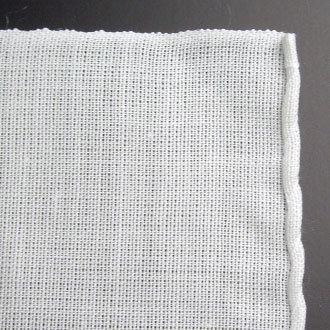 (茶巾 Chakin linen cloth)
(茶巾 Chakin linen cloth)
Tea cloths are used in preparing tea in tea ceremonies and for wiping tableware. Hemp is woven into cloth, and even today, some of these fabrics are luxury items that are carefully made without using machines – fabrics that are purely hand-spun and hand-woven.
Among linen fabrics, there is a cloth that is of the highest, topmost quality. Called Nara sarashi, these fabrics are produced in Nara Prefecture. Compared to techniques used in other linen-making areas, Nara’s methods are excellent, so much so that Nara sarashi has greatly developed due to its designation as articles used by the Shogunate government during the Edo Period.
What is “sarashi”?
Newly-woven cloth using raw yarn is light-brown in color. This cloth is washed, doused in lye, boiled in a cauldron and dried. These processes are called “sarashi”, and are repeated many times to produce beautiful white fabric.
 (On the left: Nara sarashi fabric / In the middle: Cloth processed using sarashi techniques / On the right: Raw yarn)
(On the left: Nara sarashi fabric / In the middle: Cloth processed using sarashi techniques / On the right: Raw yarn)
Since the end of the samurai era, the majority of fabrics in Japan has changed from using hemp to cotton; resulting in the decline of linen production, as well as the rapid decrease in the number of highly-skilled craftsmen.
Today, as the mechanization of many industries advances, there is a company that is daringly going back in time; cherishing handiwork and holding on to the handing down of valuable linen-making techniques.
Established in 1716, Nakagawa Masashichi is approaching is 300th year in making and selling Nara sarashi. Since its establishment, it has continued offering hand-spun, hand-woven linen fabric, but in recent years, it has also been making and selling products based on other traditional industrial arts.
They have opened a workshop where you can experience hand-spinning and hand-weaving Nara sarashi lessons so I went to find out more.
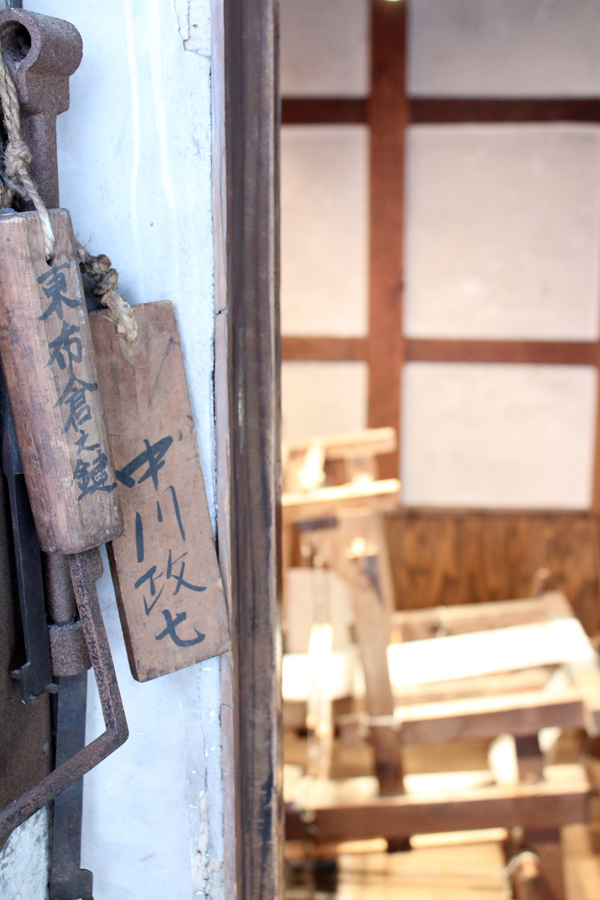
(The key to the old warehouse is still there, and the wooden plaque shown has the name of the tenth head, as well as the name “Nakagawa Masashichi,” a shop committed to the resurgence of Nara sarashi production.)
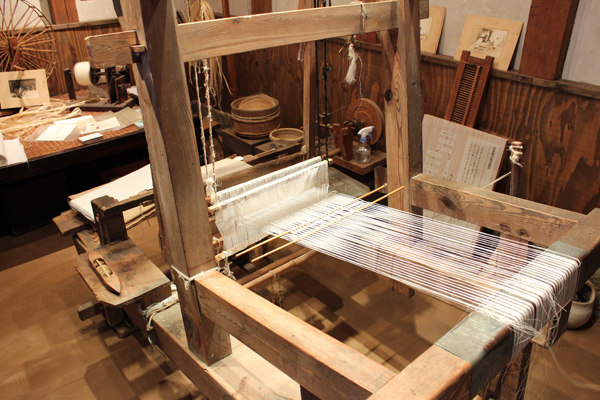 (I already had an idea on what it would look like but I was still surprised seeing the actual manually-operated loom. It hasn’t changed since the olden days and is still going strong.)
(I already had an idea on what it would look like but I was still surprised seeing the actual manually-operated loom. It hasn’t changed since the olden days and is still going strong.)
A warehouse used to store cloth has been converted into a facility where you can experience hand-spinning and hand-weaving hemp. The making of Nara sarashi has branched out into other endeavors, requiring the time and efforts of many people.
Some of Nakagawa Masashichi’s products are still made using techniques that haven’t changed since the Edo Period. It takes a skilled craftsman ten days just to weave a 24-meter cloth, and it requires 1.2 kilograms of yarn. Just to spin the yarn takes twenty-four days.
Taking this much time and effort, this is precisely the reason why the finished fabric has a warmth and texture that machine-made products don’t have.
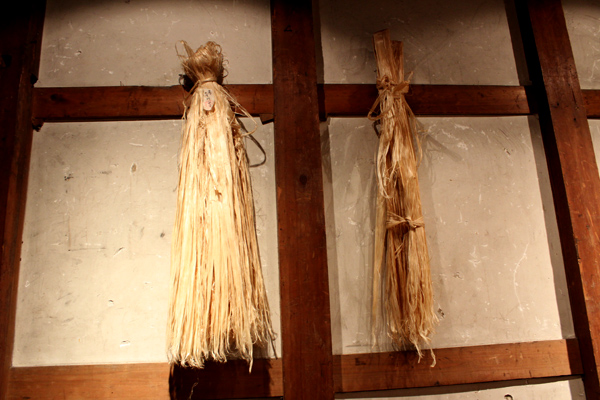
This is hemp yarn, linen fabric’s raw material. These are spun using fingers, then the finely-spun yarn is joined together to make one piece of thread.
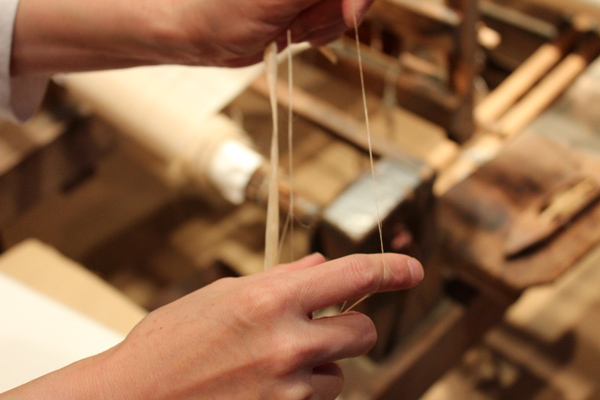
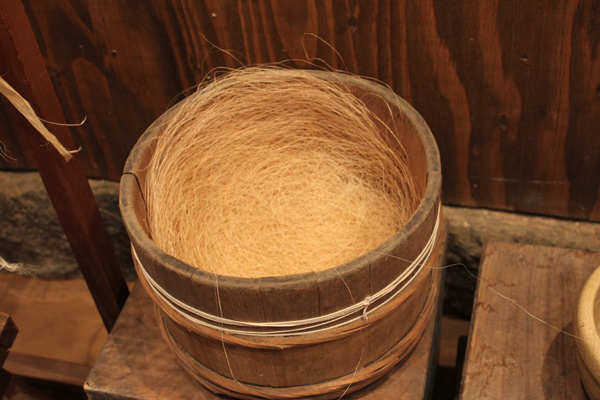
While we do need techniques like spinning thread by a machine and weaving cloth using a mechanized loom to make uniform products in large quantities, thread that is spun using the hands retains the material’s inherent good qualities and matched with the craftsman’s skill, results in a fabric with a unique texture.
Moreover, hand-spun thread can only be woven using a manually-operated loom and while this process is inefficient, production methods of the past remain unchanged and are preserved until today.
Akin to hand-made pottery, each fabric has its own character and with use, becomes more familiar and becomes an “instrument” just for oneself – just as I mentioned in the beginning when I referred to tea cloth used as an “instrument” in tea ceremonies.
Nara sarashi – made using the same methods employed hundreds of years ago. It has declined as a traditional industry, but techniques are still being handed down and production still continues although in a smaller scale. We’d like to see these fabrics with warmth and texture handed down to succeeding generations.
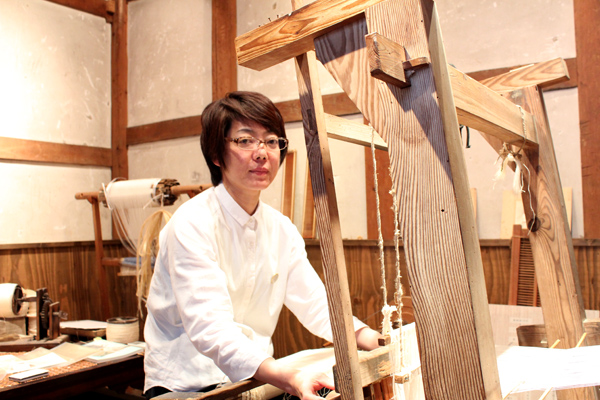 This is Ms. Tomoko Fukushima who kindly explained to me Nara sarashi’s history, the philosophies of the shop and the allure of Nara sarashi. She manages the shop and is in charge of hand-spinning and hand-weaving lessons.
This is Ms. Tomoko Fukushima who kindly explained to me Nara sarashi’s history, the philosophies of the shop and the allure of Nara sarashi. She manages the shop and is in charge of hand-spinning and hand-weaving lessons.
More information about hand-spinning and hand-weaving lessons can be found here. (You will be directed to their website.)
Nakagawa Masashichi (Main Branch)
Selling many textile products matched to today’s tastes using materials and techniques from all over Japan.
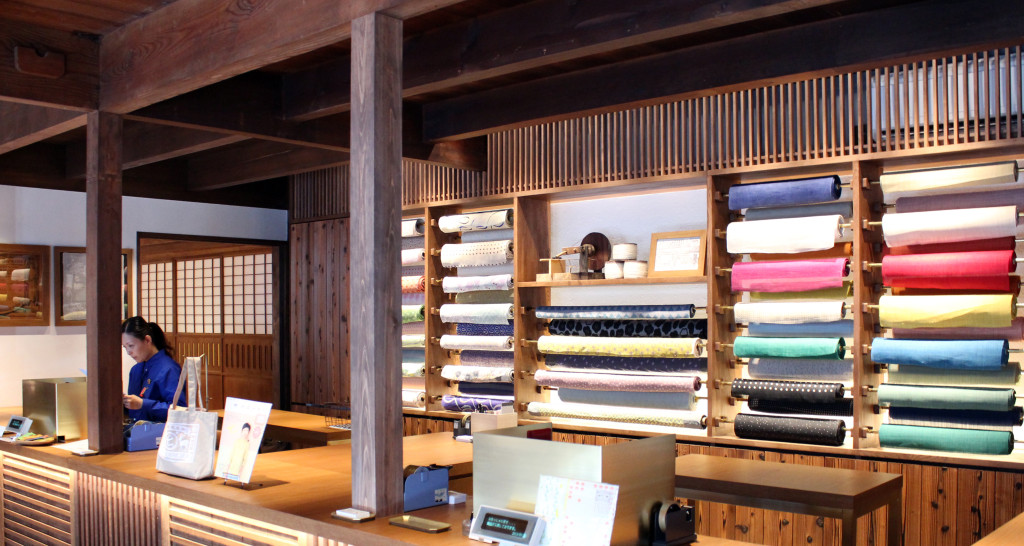
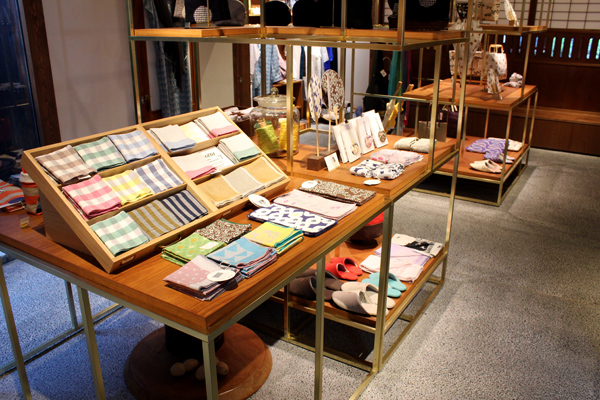
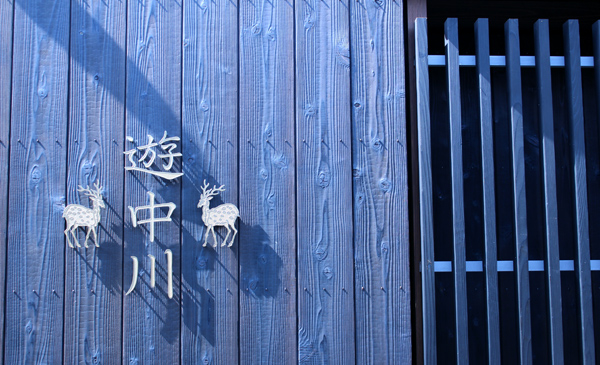
Addres:31-1 Ganrin-Cho Nara-Shi Nara-Ken
Tel: 1-742-24-2267
Web site http://www.yu-nakagawa.co.jp/
see more big map
Visiting Nakagawa Masashichi: A shop producing “Nara sarashi” – timeless hand-made linen fabric with warmth and texture using techniques handed down from generation to generation
– 2013/06/07Posted in: Japanese tablin news, traditional craft